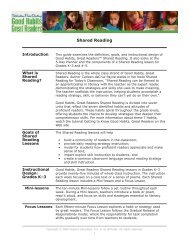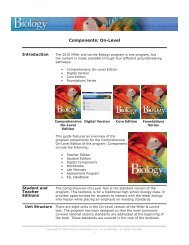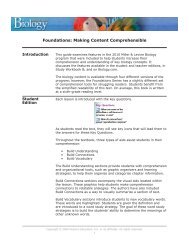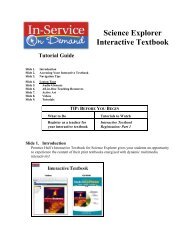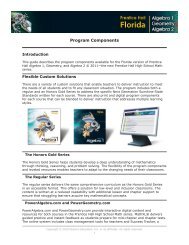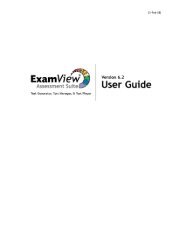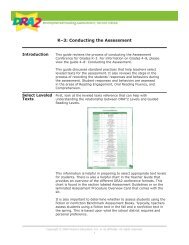Tutorial Guide: Day 5 on Reading Street - my Pearson Training
Tutorial Guide: Day 5 on Reading Street - my Pearson Training
Tutorial Guide: Day 5 on Reading Street - my Pearson Training
You also want an ePaper? Increase the reach of your titles
YUMPU automatically turns print PDFs into web optimized ePapers that Google loves.
<str<strong>on</strong>g>Tutorial</str<strong>on</strong>g> <str<strong>on</strong>g>Guide</str<strong>on</strong>g>: <str<strong>on</strong>g>Day</str<strong>on</strong>g> 5 <strong>on</strong> <strong>Reading</strong> <strong>Street</strong>: Primary GradesProgram Descripti<strong>on</strong><strong>Reading</strong> <strong>Street</strong> is a Pre-K through Grade 6 reading programdesigned to help teachers build readers by using engagingliterature, research-based instructi<strong>on</strong>, and a wealth of teachingtools.Examples from Grade 1, Unit 1 (Animals, Tame and Wild), Week 3highlight the fifth day in a week of instructi<strong>on</strong> in the primarygrades.Helpful ResourcesThe following are key items referred to in the tutorial:• Teacher’s Editi<strong>on</strong>• Read Aloud Anthology• Student Editi<strong>on</strong>• Sing with Me Big BookSome of these resources are also listed under “Materials” in the<str<strong>on</strong>g>Day</str<strong>on</strong>g> at a Glance at the beginning of the day’s instructi<strong>on</strong>.Morning Warm-UpBegin the reading and language arts block with the Morning Warm-Up. Read the message with students and discuss the Questi<strong>on</strong> ofthe <str<strong>on</strong>g>Day</str<strong>on</strong>g>: In what other ways to animals help people? Review shorto words by having students identify those words in the MorningWarm-Up.Next, revisit the Oxen S<strong>on</strong>g in the Sing with Me Big Book to buildoral vocabulary. Then, have students name things in the messagethat show how animals help people move about and stay safe. Alsohave them share words that show time or when somethinghappened.<strong>Reading</strong>Oral LanguageThe reading porti<strong>on</strong> of <str<strong>on</strong>g>Day</str<strong>on</strong>g> 5 includes a review as well as anassessment of oral vocabulary, word work, and comprehensi<strong>on</strong>strategies. It takes about 90 to 120 minutes to complete.Start the oral language instructi<strong>on</strong> by rereading Paul Bunyan andBabe in the Read Aloud Anthology. Generate a discussi<strong>on</strong> in whichstudents use the week’s Amazing Words as they talk about howanimals (both imaginary and real) help people.To m<strong>on</strong>itor students’ progress with Amazing Words, have studentsturn to the corresp<strong>on</strong>ding pages in their Student Editi<strong>on</strong>. Askstudents to talk about the pictures <strong>on</strong> these pages using theirAmazing Words.- 1 -Copyright ©2008 Pears<strong>on</strong> Educati<strong>on</strong>, Inc. or its affiliates. All rights reserved.
Word WorkBefore moving <strong>on</strong> to assessment, review the week’s target ph<strong>on</strong>icsskills by having students identify short o words and plural wordsthat end with s. Write these sentences <strong>on</strong> the board and call <strong>on</strong>students to read the underlined words.Students can also practice reading high-frequency words. Havestudents look at the Words to Read found in their Student Editi<strong>on</strong>,and then find these words <strong>on</strong> the Word Wall. Next, students canuse the words to complete sentences in this rhyme.Then assess students’ spelling of short o words by administeringthe spelling test.Small Group PlanAfter spelling, it’s time to break into small groups for more focusedinstructi<strong>on</strong>. <strong>Reading</strong> <strong>Street</strong> provides a daily Small Group Plan forOn-Level, Strategic Interventi<strong>on</strong>, and Advanced students.While working with small groups, assign the Independent Activitiesto the rest of the class.Group TimeThe Group Time chart indicates where to find the small groupless<strong>on</strong> plan. It has a descripti<strong>on</strong> for small group reading for On-Level, Strategic Interventi<strong>on</strong>, and Advanced students.The less<strong>on</strong> plans for Strategic Interventi<strong>on</strong> and Advanced groupsare found in the back of the Teacher’s Editi<strong>on</strong> behind theDifferentiated Instructi<strong>on</strong> tab.On-LevelTo assess short o words, plural words that end in s, and highfrequencywords, use the word list found in the Teacher’s Editi<strong>on</strong>.Have each student read the words <strong>on</strong> the list. Then, use thesentence lists in the Teacher’s Editi<strong>on</strong> to have students read wordsin the c<strong>on</strong>text of a sentence. Call <strong>on</strong> individuals to read two of thesentences in Set B.To assess comprehensi<strong>on</strong>, have students identify and describestory characters and setting by asking the following questi<strong>on</strong>s:• How would you describe Ox from the Big Blue Ox?• Where does the story take place?Use the appropriate page, located behind the Writing andAssessment tab in the back of the Teacher’s Editi<strong>on</strong>, to recordstudents’ scores for each story in the unit.- 2 -Copyright ©2008 Pears<strong>on</strong> Educati<strong>on</strong>, Inc. or its affiliates. All rights reserved.
Strategic Interventi<strong>on</strong>The students in the Strategic Interventi<strong>on</strong> group will benefit fromadditi<strong>on</strong>al review and practice with short o words, plural words thatend in s, and high-frequency words.Assess them using the appropriate word list in the Teacher’sEditi<strong>on</strong>. If students are successful, c<strong>on</strong>tinue with the Sentence<strong>Reading</strong> Assessment, this time using Set A.AdvancedFor the Advanced students, skip the word reading list and movestraight to the Sentence <strong>Reading</strong> Assessment found in theTeacher’s Editi<strong>on</strong>. Have the students read the sentences in Set C.For both the Strategic Interventi<strong>on</strong> and Advanced students, usethe same questi<strong>on</strong>s used with the On-Level group to assesscomprehensi<strong>on</strong>.Use the appropriate page, located behind the Writing andAssessment tab in the back of the Teacher’s Editi<strong>on</strong>, to recordscores for all of the students as they progress through the unit.Additi<strong>on</strong>al AssessmentThere are additi<strong>on</strong>al assessment resources to c<strong>on</strong>sider usingthroughout the week.The Selecti<strong>on</strong> Tests can be used to check comprehensi<strong>on</strong> of themain selecti<strong>on</strong> and high-frequency words. Use Fresh Reads forDifferentiated Instructi<strong>on</strong> to check the weekly targetcomprehensi<strong>on</strong> skills and fluency. Look for record-keeping forms,observati<strong>on</strong> checklists, and additi<strong>on</strong>al assessment ideas in theAssessment handbook.The items are located in the Teacher’s Resource package.Language ArtsWriting and GrammarAfter students are assessed during small group time, bring themback together as a whole group to work <strong>on</strong> language arts. Expectthe daily instructi<strong>on</strong> in writing and grammar to take about 20 to 30minutes.On <str<strong>on</strong>g>Day</str<strong>on</strong>g> 5, you’ll use the related pages of the Student Editi<strong>on</strong> toguide students in resp<strong>on</strong>ding to writing prompt.Students will write sentences that tell what animals do to helppeople. Throughout the week, they have worked <strong>on</strong> writingsentences through shared and interactive experiences. On <str<strong>on</strong>g>Day</str<strong>on</strong>g> 5,they will write independently.For additi<strong>on</strong>al practice with identifying the acti<strong>on</strong> parts ofsentences, students can complete the related page in theirGrammar and Writing Practice Book.- 3 -Copyright ©2008 Pears<strong>on</strong> Educati<strong>on</strong>, Inc. or its affiliates. All rights reserved.
Research and StudySkillsWrap Up Your <str<strong>on</strong>g>Day</str<strong>on</strong>g>Before the week comes to a close, you can also work with yourstudents <strong>on</strong> research and study skills. For example, this weekyou’re teaching students about reading for informati<strong>on</strong>. Using theappropriate page of the Picture Dicti<strong>on</strong>ary in the back of theStudent Editi<strong>on</strong>, model for students how the words and picturesare organized to help them acquire and learn informati<strong>on</strong>.Wrap up the week by reviewing what students learned during theweek. Revisit the Questi<strong>on</strong> of the Week: How can animals helppeople? Display the Past/Present T-Chart you developed withstudents <strong>on</strong> <str<strong>on</strong>g>Day</str<strong>on</strong>g> 1. Lead a discussi<strong>on</strong> around the weekly questi<strong>on</strong>and invite students to add ideas to the chart and discuss what theylearned from the weekly selecti<strong>on</strong>s.You can also preview the next week for students by telling themthat they’ll read about how we can learn from animals by watchingthem.ReviewThis tutorial looked at an example of the fifth day of instructi<strong>on</strong>with <strong>Reading</strong> <strong>Street</strong> in the primary grades.The fifth day of instructi<strong>on</strong> includes the Morning Warm-Up; readinginstructi<strong>on</strong> with oral language, word work, and group time withassessment; and language arts instructi<strong>on</strong> that includes writingand grammar as well as research and study skills.There will be some differences between the units as the yearprogresses.- 4 -Copyright ©2008 Pears<strong>on</strong> Educati<strong>on</strong>, Inc. or its affiliates. All rights reserved.




